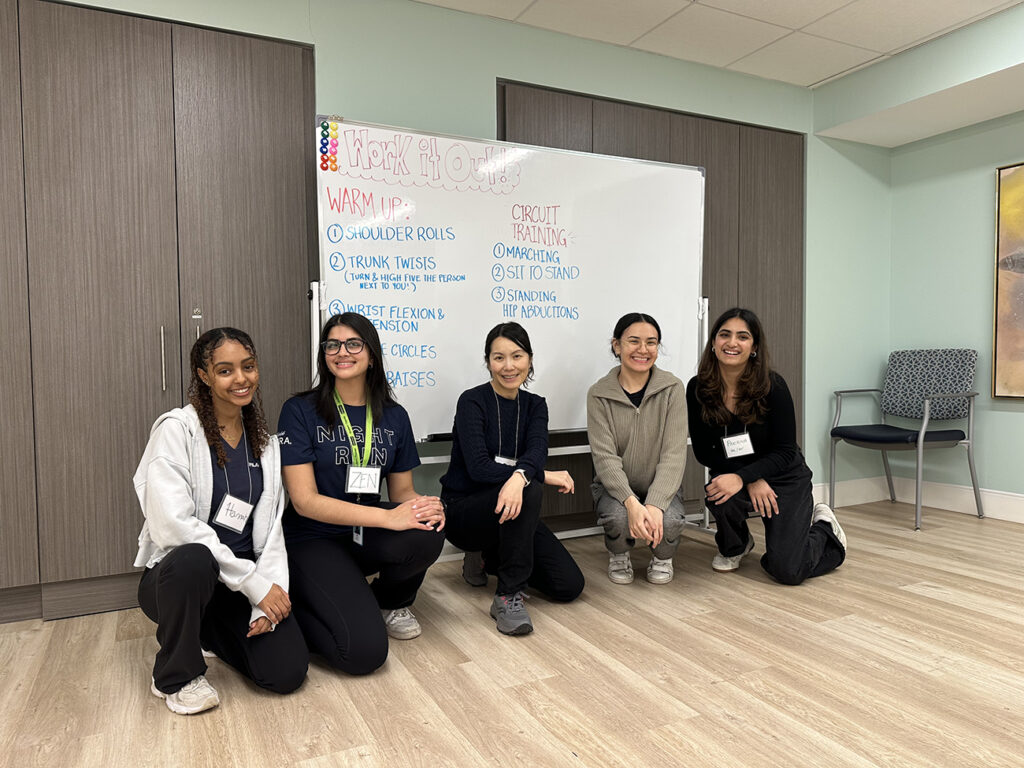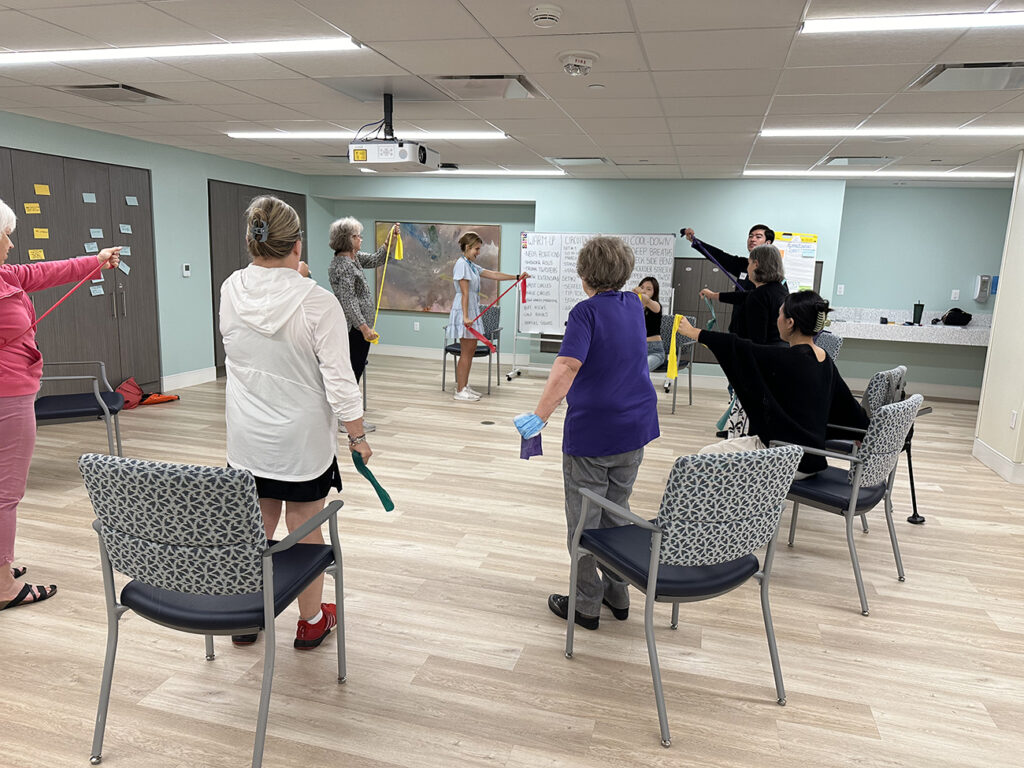Partnership with Baycrest expands the impact of the Talk It Out, Work It Out program
Categories: Faculty, Lin Fang, Partners, Practicum, Students
Left to right: Hanna Ali (MSW student), Zen Kapadia (KPE student), FIFSW Professor Lin Fang, Robia Mohammadi (MSW student), and Prerna Sharma (MSW student).
In an activity room in Toronto’s new Baycrest Kimel Family Centre for Brain Health and Wellness, a dozen people are immersed in conversation. Standing by a whiteboard, an instructor named Ash Kaura is explaining the psychological concept of the “window of tolerance” – that zone in which we feel equipped to handle whatever life is throwing at us. It’s a fancy academic term but with this group of older adults, it landed.
“Anyone feel like you’re outside your window a bit?” Ash asked.
Nods all around.
Our window of tolerance can shrink as we age. Building the skills to become more resilient — both emotionally and physically — is one of the main goals of this innovative program of multimodal therapy.
As the chat winds down, Kaura and her co-facilitator — both masters graduates in social work — prepare to ease the participants into phase two: getting their bodies involved in what their minds just decanted. There will be “functional movement” exercises, the sort that will help the older adults build strength in everyday tasks. Also: there might be dancing.
This is Talk It Out, Work It Out at Baycrest. Funded by Janis Rotman, the program is building on the momentum of the original Talk It Out Work It Out initiative created by two Faculties at the University of Toronto: the Factor-Inwentash Faculty of Social Work and the Faculty of Kinesiology & Physical Education. In partnering Baycrest, a world-leading institution for brain health and wellness, Talk It Out Work It Out has been able to broaden its impact and reach. The new iteration of the program engages older adults living with assisted care at the Baycrest Terraces retirement residence and those in the broader community who access the Kimel Family Centre’s services.
“The Kimel Family Centre’s research focuses on modifiable lifestyle factors, such as physical activity, mental wellbeing, cognitive engagement and social connections – and the Talk It Out Work It Out program addresses them all,” says Alyssa Manalo, Kimel Family Centre’s fitness coordinator. “We emphasize social connections in all our programs, and this program, specifically, has been great at building a true community among our members. It’s even inspired them to join other programs, which in turn supports our research on dementia prevention and reducing dementia risk.”
The idea for Talk It Out, Work It Out originally hatched during the pandemic, when the forced isolation of the COVID-19 lockdown was playing hell on everyone — but especially on seniors in marginalized communities, who were severed from many of their loved ones and support systems and prevented from moving around very much.
Working together, masters students from both Faculties, under the supervision of professional staff and faculty members, created mind-body group intervention that they could take into the community. During the pilot, funded by Joan and Bernard Aaron, eager clientele at the Jane-Finch Centre lapped up the students’ ministrations. The number of participants quickly quadrupled as word spread about how great this was for everyone involved.
Here’s how Talk It Out, Work It Out goes: Once a week, the facilitators and participants meet to move through an eight-week curriculum. There’s a different theme each session, for example: “social support,” “goal-setting,” “motivation.” The participants are typically dealing with several types of anxieties and challenges — the stress of pain, of finances, of work. In the program with Baycrest, half the clientele comes from the community and many are not yet retired. But everyone agrees: it feels good to air this stuff out.
“The talk quickly goes deep,” says Professor Lin Fang, the Endowed Chair in Children’s Mental Health at the Factor-Inwentash Faculty of Social Work and founder and director of the Talk It Out Online Counseling Clinic. She developed the Talk It Out, Work It Out programs in collaboration with Kinesiology Professor Catherine Sabiston, Canada Research Chair in Physical Activity and Mental Health.

Clara Rivaya Salvadores leads Talk It Out Work IT Out participants in an exercise using resistance bands
A core value of the entire program is self-care. It’s a new concept for many of the participants — the women particularly. They may never have allowed themselves to really think about their own needs. “They’ve spent their whole lives taking care of others,” says Clara Rivaya Salvadores, the lead instructor on the kinesiology side. “I like to introduce the analogy, ‘You have to put on your own oxygen mask first.’ You have to, in effect, learn to become your own best friend,” giving yourself time and permission to take care of your own physical and mental health.
The mindshift is an adjustment, to say the least. And, just practically, it can require some creative swerves.
In one session, a participant disclosed that she found it a herculean struggle to find time for physical activity. She was a schoolteacher, with never-ending grading.
Rivaya Salvadores was sympathetic: “Making time for this is hard for everyone!” But, she suggested, even if we can’t make it to the gym, or outside for a walk, we can still squeeze in tiny bursts of activity throughout the day — something kinesiologists call “exercise snacks.”
“You can be done in two minutes,” Salvadores says. “Get your energy levels up, get a smile on your face.” Right there and then, the two of them indulged in an exercise snack together: they performed some squats.
The science behind Talk It Out, Work It Out is sound. More than a hundred thousand peer-reviewed studies support the cognitive benefits of physical movement (not to mention the obvious physical benefits). “A lot of the people we work with, they generally know that that’s the case — that there’s a link between physical health and mental health,” says Manalo. “But it’s one thing to know it; it’s another thing to experience it for yourself … to feel it.”
There’s also a “teach a human to fish” element to a lot of this work. On both the Talk it Out and the Work It Out side, participants develop tools they can use long after the program ends, such as meditation techniques and “self-talk” skills to become their own “life coach,” in a sense. “They get adept at observing themselves and their own reactions, at answering the question, ‘What is happening to me?’” says Kaura, the Master of Social Work student.
As for the student facilitators, they have discovered an unexpected benefit going their way – apart from valuable practical experience in work that many will make a career of. “In those Talk It Out sessions, what ended up happening was, a space opened up for [the participants] to provide some of their wisdom and perspective to us instructors,” says Rivaya Salvadores. “We all realized: I’m not just hear to teach. I’m here to share. And I’m here to learn.”
One of the big payoffs participants report is an energy boost. In the Talk It Out sessions, as the participants relax, as trust builds and as tensions release, energy spikes. Participants then ride that momentum into the Work It Out Portion, where more juice yet is ginned up. Energy begets energy.
“We find that when the session’s over, a lot of the participants want to stay on and talk again,” says Manalo. Left to its natural conclusion, Talk It Out, Work It Out would snowball into Talk It Out, Work It Out, Talk It Out, Work It Out …. until the instructors went home to dinner, and the custodians turned out the lights.
“That’s something we didn’t expect – that people wouldn’t want to leave,” says Manalo. “They wanted another dose! It was intended as a one-and-done thing; one of the main goals of the program was then when people come out of it they’d feel well enough to carry on in their life. But the participants told us they didn’t want to be done. They want to come back. “
And in the meantime they’re telling everyone they know about it.
By Bruce Grierson
Visit the Talk It Out website to learn more about its partners and supporters.